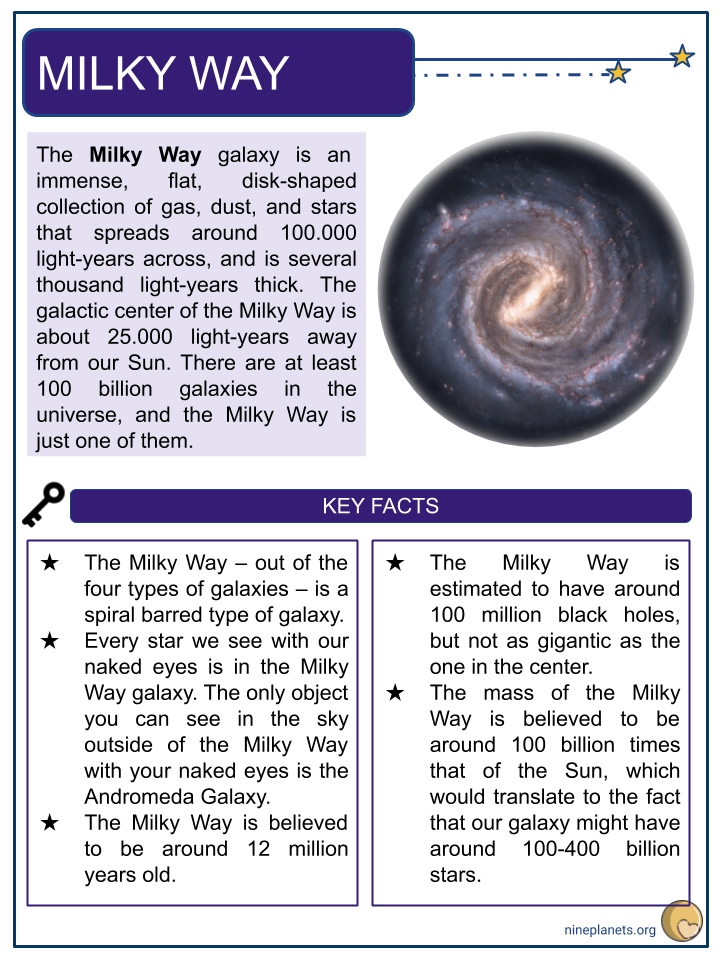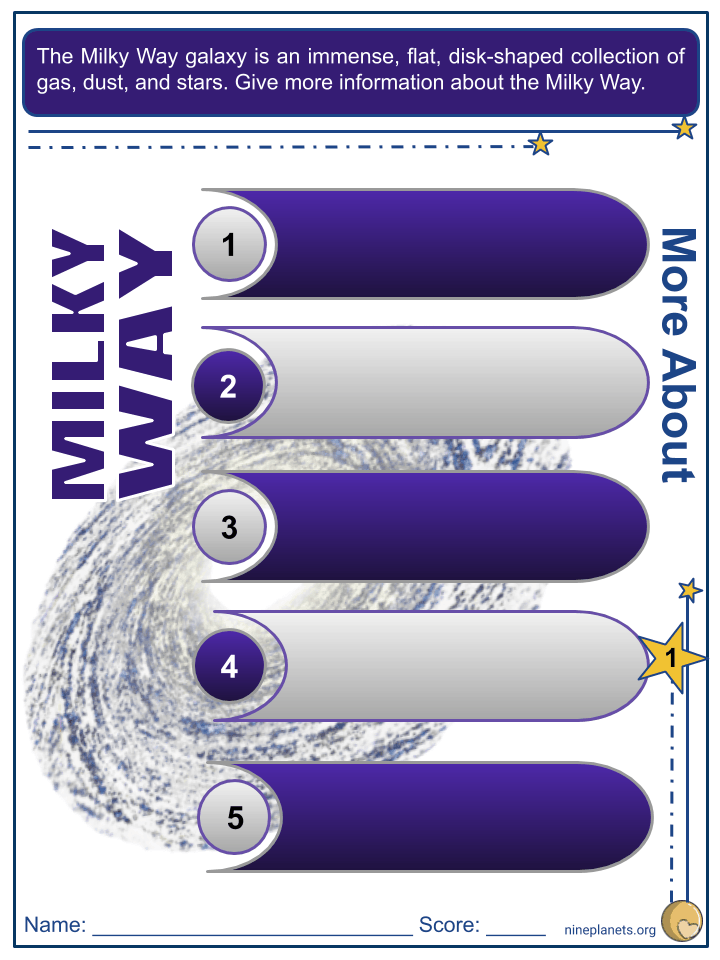Download Milky Way Worksheets
Click the button below to get instant access to these premium worksheets for use in the classroom or at a home.

This worksheet can be edited by Premium members using the free Google Slides online software. Click the Edit button above to get started.
Download free sample
Not ready to purchase a subscription yet? Click here to download a FREE sample of this worksheet pack.
Resource Examples
Click any of the example images below to view a larger version.




Key Facts & Information
- The Milky Way galaxy is an immense, flat, disk-shaped collection of gas, dust, and stars that spreads around 100.000 light-years across, and is several thousand light-years thick. The galactic center of the Milky Way is about 25.000 light-years away from our Sun. There are at least 100 billion galaxies in the universe, and the Milky Way is just one of them.
- The Milky Way – out of the four types of galaxies – is a spiral barred type of galaxy.
- Every star we see with our naked eyes is in the Milky Way galaxy. The only object you can see in the sky outside of the Milky Way with your naked eyes is the Andromeda Galaxy.
- The Milky Way is believed to be around 12 million years old.
- The Milky Way is estimated to have around 100 million black holes, but not as gigantic as the one in the center.
- The mass of the Milky Way is believed to be around 100 billion times that of the Sun, which would translate to the fact that our galaxy might have around 100-400 billion stars.
Ancient Times
- Since ancient times humanity has been able to observe a faint fuzzy glow stretching in the night sky. This glow strongly resembles a pathway or a river. Many ancient cultures saw it that way because it glows white. The ancient people of Greece called it “Galaxius”, or “Milky”. Over the millennia that name remained and underwent different variations, and stuck to this day.
Discovery
- Nobody knew what exactly this glow was, until Galileo Galilei pointed his telescope at it in 1610, and saw that the glow was actually a collection of thousands of stars.
- For a period of time, some believed that the galaxy is as big as the universe itself. However, many observations were further conducted.
- Astronomer Edwin Hubble published his works in 1929, concluding that the Milky Way was just one out of many other galaxies.
- Seven decades later, a telescope named in Hubble’s honor helped discover that the observable universe was truly vast, and contained nearly 100 billion galaxies.
Formation
- How the Milky Way formed is still a matter of debate. The Big Bang theory suggests that after the explosion, the universe was composed of radiation and subatomic particles.
- There are two strong viewpoints here:
- Small particles slowly teamed up and gradually formed stars, star clusters, and eventually galaxies.
- The universe first organized as immense clumps of matter that later subdivided into galaxies.
- It is still up to debate. However, we know that the Milky Way galaxy grew by merging with other galaxies. Almost half of the matter in the Milky Way is believed to have come from other distant galaxies.
- When the first stars of the Milky Way were born, the mass was large enough for the galaxy to spin relatively quickly.
- This led the gaseous interstellar medium to collapse from a roughly spheroidal shape – to that of a disk. Later-generation stars formed in this spiral disk, with the younger stars including our Sun, currently observed to be in the disk.
- These very old stars and clusters now comprise the galactic halo of our galaxy. It continued to grow by merging and because of the accretion of gas that came directly from the galactic halo.
Location
- The Milky Way galaxy and the Andromeda galaxy are a binary system of giant spiral galaxies belonging to a group of 50 closely bound galaxies known as the Local Group.
- The Local Group is surrounded by a Local Void, itself being part of the Virgo Supercluster of galaxies. The Virgo Supercluster is also surrounded by giant voids such as the Microscopium Void, Sculptor Void, Bootes Void, and Canes-Major Void.
- The voids change shape over time, creating filamentous structures of galaxies. The Virgo Supercluster, for instance, is being drawn towards the Great Attractor, which in turn forms part of a greater structure named Laniakea.
Size, Mass & Distance
- The Milky Way is part of the Local Group, holding the second title as the largest galaxy in it. Its stellar disk is approximately 100.000 light-years / 30 kpc in diameter.
- It is approximately 1.000 light-years / 0.3 kpc thick. The Local Group is about 10 million light-years across, and the Andromeda galaxy is the most massive galaxy in it. The Milky Way is the second-most massive.
- The Milky Way is almost 1.5 trillion times the mass of the Sun. If the Solar System were the size of a coin, the Milky Way would be the size of the contiguous United States.
- Much of the mass seems to be dark matter, an unknown and invisible form of matter that interacts gravitationally with ordinary matter.
- Milky Way’s mass has a radius of about 129.000 light-years. This suggests that about 90% of the mass is comprised of dark matter.
Galactic Rotation / Orbit
- All the stars and gas of our galaxy orbit a supermassive black hole located at the center of the galaxy named Sagittarius A*. The Sagittarius A* is around 28.000 light-years away from Earth.
- The stars and gas rotate around the center differentially, meaning that the rotation period varies with location. A typical characteristic of spiral galaxies is that the orbital speeds of most stars do not depend strongly on their distance from the center.
Structure & Contents
- The Milky Way consists of a bar-shaped core region that is surrounded by a warped disk of gas, dust, and stars. It is a spiral galaxy with relatively loosely wound arms. It is made up of about 90% dark matter, matter which cannot be seen, and about 10% “luminous matter”, or matter that we can see with our eyes.
- The Milky Way galaxy has 4 major spiral arms, which are sights of strong star formation.
- Spiral Arms. The 4 major spiral arms of the Milky Way contain a higher density of interstellar gas, dust and a greater concentration of star formation than the rest of the galaxy.
- The cyan, purple, green, and pink colors represent the major arms. They are called: the Perseus Arm, Outer Arm, Scutum-Centaurus Arm, and Carina-Sagittarius arm.
- The orange color represents the two minor arms, which also contains our solar system. They are the Orion and Cygnus Arm.
- Black Holes. In the center of the Milky Way is Sagittarius A*, a supermassive black hole. It has a mass of about 4.3 million times that of our Sun and it is near the border of the constellations Sagittarius and Scorpio.
- Sagittarius A* is not the only black hole in the Milky Way. Estimations suggest that there are over 100 million black holes in the Milky Way alone with two dozen already discovered, but they are small.
- Halo. The Milky Way’s galactic disk is surrounded by a spheroidal halo of old stars and globular clusters. About 90% of them lie within 100.000 lights-years of the Galactic Center. Almost 40% of the clusters in our galaxy are on retrograde orbits, moving in the opposite direction from the Milky Way rotation.
- Stars. The Milky Way contains hundreds of billions of stars of all different types, shapes, and sizes. The closest star to us (with the exception of our Sun), is a star named Proxima Centauri, at about 4.3 light-years the average distance. Perhaps the oldest star in the Milky Way that we have detected is a star named SMSS J0313-6708. It is estimated to be 13.6 billion years old at a distance of 6.000 light-years from Earth. The largest known star in the Milky Way is believed to be the Pistol Star. It is a star believed to be 100 times more massive than our Sun, and 10.000.000 times as bright.
- Exoplanets. Exoplanets are planets that orbit other stars, just like the planets in our solar system orbit the Sun. There are around 4.099 confirmed exoplanets in the Milky Way. The Milky Way is estimated to have billions of planets, some of them orbiting stars, while others drifting alone in space bearing the name “rogue planets”.